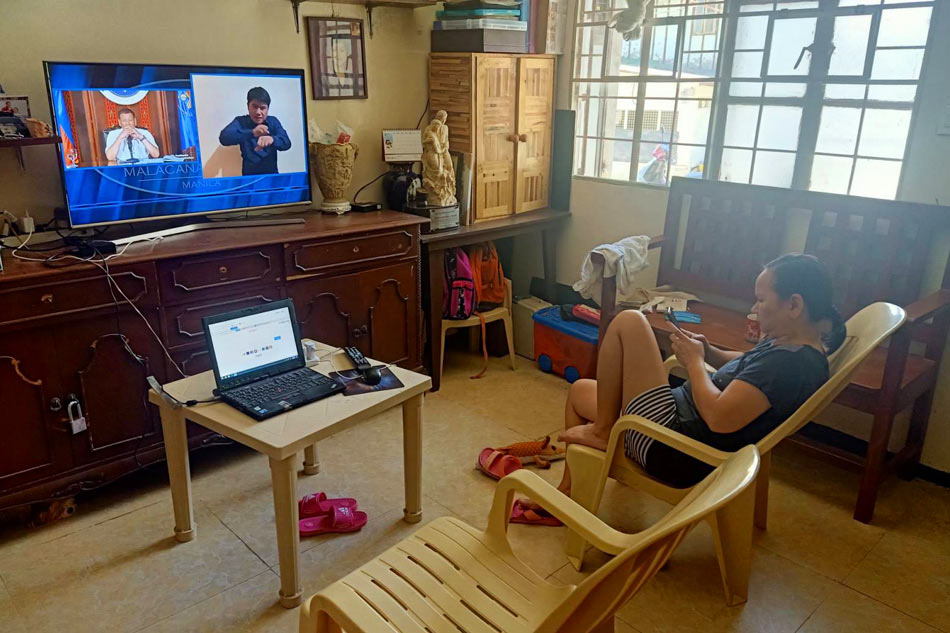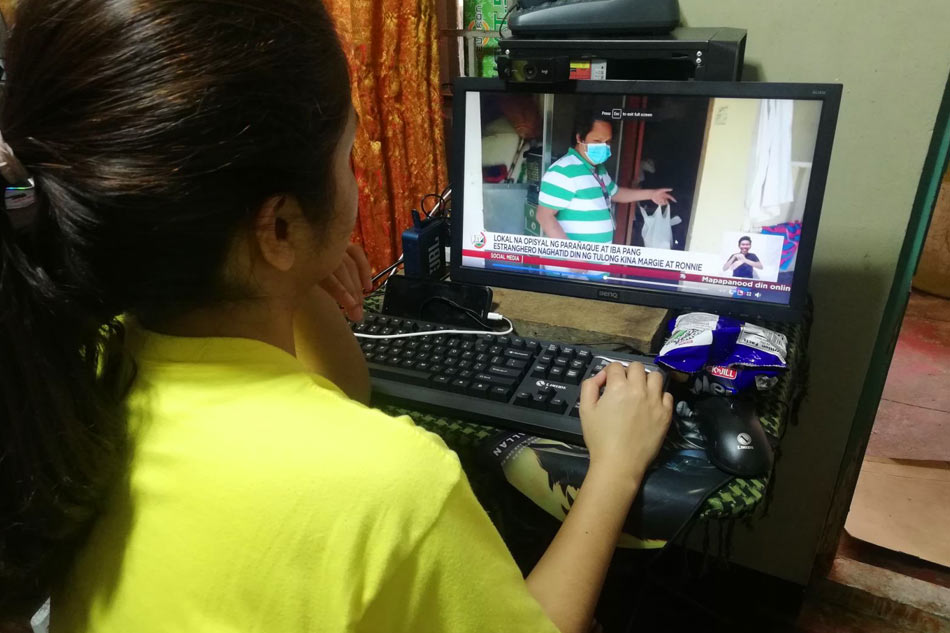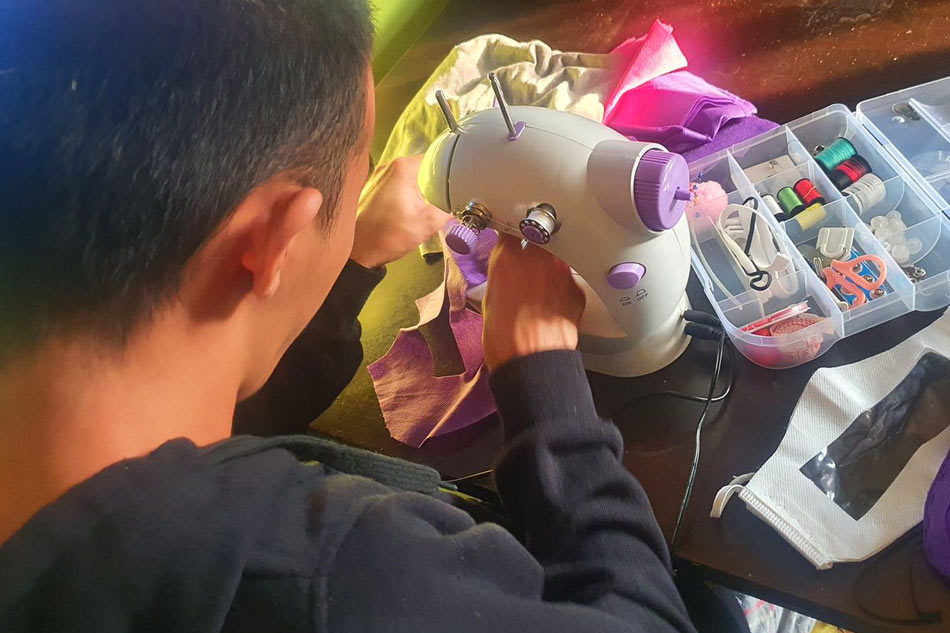Feeling left out, deaf community seeks government help to adjust to new normal | ABS-CBN

Welcome, Kapamilya! We use cookies to improve your browsing experience. Continuing to use this site means you agree to our use of cookies. Tell me more!
Feeling left out, deaf community seeks government help to adjust to new normal
Feeling left out, deaf community seeks government help to adjust to new normal
Angel Movido,
ABS-CBN News
Published May 20, 2020 06:48 PM PHT
MANILA -- The Philippine Federation of the Deaf (PFD) is urging the government to boost internet connections for the deaf community.
MANILA -- The Philippine Federation of the Deaf (PFD) is urging the government to boost internet connections for the deaf community.
Since the COVID-19 pandemic in March, stay-at-home measures have been implemented and social gatherings prohibited. School classes were suspended, while face-to-face meetings, hearings and press conferences and the like were all held online.
Since the COVID-19 pandemic in March, stay-at-home measures have been implemented and social gatherings prohibited. School classes were suspended, while face-to-face meetings, hearings and press conferences and the like were all held online.
According to PFD president Carolyn Dagani, inborn deaf herself, said the government should consider their needs, especially now in the new normal.
“We need technology. How is it gonna work for the, kunwari maralita sila, ang laptop or internet, paano 'yun? Kasi senyas 'yung amin. I want to emphasize the inclusiveness of everything,” Dagani emphasized through Joi Villareal, a sign language interpreter and vice president of the Philippine National Association of Sign Language Interpreters.
According to PFD president Carolyn Dagani, inborn deaf herself, said the government should consider their needs, especially now in the new normal.
“We need technology. How is it gonna work for the, kunwari maralita sila, ang laptop or internet, paano 'yun? Kasi senyas 'yung amin. I want to emphasize the inclusiveness of everything,” Dagani emphasized through Joi Villareal, a sign language interpreter and vice president of the Philippine National Association of Sign Language Interpreters.
“Hindi lahat ng mga deaf may access sa internet. And another 'yung ating bandwidth, 'yung internet. Sa atin kahit medyo mawala-wala ka, okay lang eh. Dahil kami sign language, kailangan reliable 'yung signal mo pero fast enough; kung nag-freeze ng kaunti, wala na,” added Liza Martinez, a linguist and a member of the University of the Philippines’ Filipino Sign Language Task Force.
“Hindi lahat ng mga deaf may access sa internet. And another 'yung ating bandwidth, 'yung internet. Sa atin kahit medyo mawala-wala ka, okay lang eh. Dahil kami sign language, kailangan reliable 'yung signal mo pero fast enough; kung nag-freeze ng kaunti, wala na,” added Liza Martinez, a linguist and a member of the University of the Philippines’ Filipino Sign Language Task Force.
ADVERTISEMENT
Dagani is also appealing to government agencies to create partnerships to provide effective communication tools, accessible information and education for the deaf.
Dagani is also appealing to government agencies to create partnerships to provide effective communication tools, accessible information and education for the deaf.
“Help us ask government to pay for interpreting services. Sana they should allot budget coming from the GAA (General Appropriations Act), na dun ikaltas,” she urged.
“Help us ask government to pay for interpreting services. Sana they should allot budget coming from the GAA (General Appropriations Act), na dun ikaltas,” she urged.
Dagani added that information they get from media also plays a vital role, citing there should be more provision for insets for the deaf.
Dagani added that information they get from media also plays a vital role, citing there should be more provision for insets for the deaf.
“Lalo sa 'min na malalabo ang mata na deaf. Kasi halimbaawa deaf ka na nga, tapos malabo pa 'yung mata mo, eventually magiging deaf ka at blind. What you have we want to experience also, so we want our insets bigger also,” Dagani said through sign language.
“Lalo sa 'min na malalabo ang mata na deaf. Kasi halimbaawa deaf ka na nga, tapos malabo pa 'yung mata mo, eventually magiging deaf ka at blind. What you have we want to experience also, so we want our insets bigger also,” Dagani said through sign language.
Martinez shared, for instance, how they struggled to make the deaf community understand the COVID-19 pandemic.
Martinez shared, for instance, how they struggled to make the deaf community understand the COVID-19 pandemic.
ADVERTISEMENT
“Ang hearing people alam nila lahat in advance. So ang pakiramdam namin was (it's) really important to have full communication, kasi parang napaka-limited, paunti-unti lang nakukuha naming information. We really felt it was not fair,” Martinez shared.
“Ang hearing people alam nila lahat in advance. So ang pakiramdam namin was (it's) really important to have full communication, kasi parang napaka-limited, paunti-unti lang nakukuha naming information. We really felt it was not fair,” Martinez shared.
Together with 9 other interpreters and deaf leaders, Martinez and Dagani also formed the Filipino Sign Language Access for COVID-19.
Together with 9 other interpreters and deaf leaders, Martinez and Dagani also formed the Filipino Sign Language Access for COVID-19.
“Kung wala kaming interpreting, marami na nagsabi na mamamatay ang sa deaf community because we didn’t know what was going on,” Martinez added.
“Kung wala kaming interpreting, marami na nagsabi na mamamatay ang sa deaf community because we didn’t know what was going on,” Martinez added.
The group is also proposing the creation of a national interpreting system, that will enable the deaf to effectively communicate even with normal citizens who do not understand or know how to do sign language.
The group is also proposing the creation of a national interpreting system, that will enable the deaf to effectively communicate even with normal citizens who do not understand or know how to do sign language.
“Through technology pwede, we can have like a relay service,” Dagani’s interpreter said.
“Through technology pwede, we can have like a relay service,” Dagani’s interpreter said.
ADVERTISEMENT
The World Health Organization reports that about 10-15% of a country’s population have various physical disabilities. Data from the Philippines, Martinez believes, is outdated, citing only more than 100,000 with hearing disabilities.
The World Health Organization reports that about 10-15% of a country’s population have various physical disabilities. Data from the Philippines, Martinez believes, is outdated, citing only more than 100,000 with hearing disabilities.
Face masks for the deaf
Even the new normal of wearing face masks has now become a communication barrier for the deaf community.
Even the new normal of wearing face masks has now become a communication barrier for the deaf community.
Aside from the deaf, the PFD has since urged all their interpreters to stay at home because of the COVID-19 threat. Sign language communication is now heavily being done through videos and the web.
Aside from the deaf, the PFD has since urged all their interpreters to stay at home because of the COVID-19 threat. Sign language communication is now heavily being done through videos and the web.
“Mahalaga sa wikang senyas 'yung facial expression. Kung hard of hearing ka, at umaasa ka sa speech reading, barrier talaga may mask, kasi hindi mo makikita bibig niya. It's also hard to see other aspects of the language,” Dagani said through her interpreter.
“Mahalaga sa wikang senyas 'yung facial expression. Kung hard of hearing ka, at umaasa ka sa speech reading, barrier talaga may mask, kasi hindi mo makikita bibig niya. It's also hard to see other aspects of the language,” Dagani said through her interpreter.
Educator and Filipino sign language advocate Pia Gonzales-Jacinto shared how her group from the Department of Education started making sample face masks for the deaf, especially for those who rely on lip reading.
Educator and Filipino sign language advocate Pia Gonzales-Jacinto shared how her group from the Department of Education started making sample face masks for the deaf, especially for those who rely on lip reading.
ADVERTISEMENT
“Gumagawa kami ng clear face mask, para makikita ng mga deaf na meron access, makikita pa rin pero at the same time protected sila,” Gonzales said.
“Gumagawa kami ng clear face mask, para makikita ng mga deaf na meron access, makikita pa rin pero at the same time protected sila,” Gonzales said.
Considered an invisible disability, the deaf will need more access to making sign language understandable to the normal person especially in the new normal.
Considered an invisible disability, the deaf will need more access to making sign language understandable to the normal person especially in the new normal.
“Magkaroon ng awareness, bigyan ng accessibility ang sign language, training at workshop, bigyan ng priority 'yung deaf community,” Jacinto urged.
“Magkaroon ng awareness, bigyan ng accessibility ang sign language, training at workshop, bigyan ng priority 'yung deaf community,” Jacinto urged.
The Department of Education is also offering online courses for those who want to learn the Filipino sign language.
The Department of Education is also offering online courses for those who want to learn the Filipino sign language.
ADVERTISEMENT
ADVERTISEMENT




